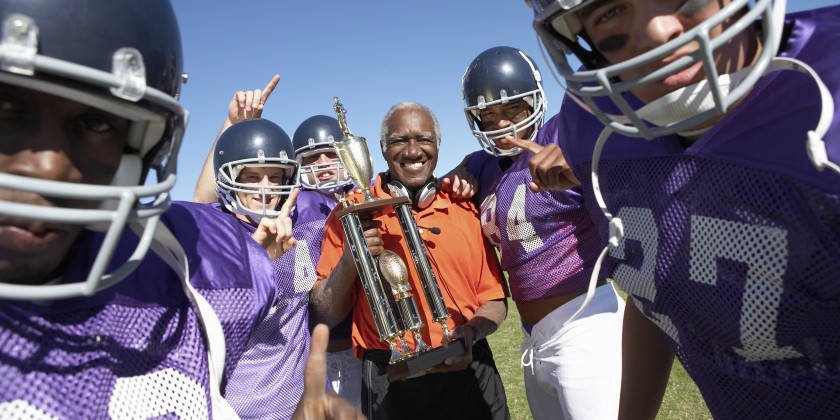The Dalai Lama says that “a calm mind brings inner strength and self-confidence, so that’s very important for good health.” What happens when an injury occurs to your calm mind (brain)? Unfortunately, we are finding out since more than 1 million mild traumatic brain injuries occur nationwide each year.
The CDC defines a concussion1 as a type of brain injury. It’s a minor form. Technically, a concussion is a short loss of normal brain function in response to a head injury. But people often use it to describe any minor injury to the head or brain.
Concussions are a common type of sports injury. You can also have one if you suffer a blow to the head or hit your head after a fall.
Symptoms of a Concussion
Symptoms of a concussion may not start right away; they may start days or weeks after the injury. Symptoms may include a headache or neck pain. You may also have nausea, ringing in your ears, dizziness, or tiredness. You may feel dazed or not your usual self for several days or weeks after the injury. Consult your health care professional if any of your symptoms get worse, or if you have more severe symptoms such as
- Seizures
- Trouble walking or sleeping
- Weakness, numbness, or decreased coordination
- Repeated vomiting or nausea
- Confusion
- Slurred speech
Doctors use a neurologic exam and imaging tests to diagnose a concussion. Most people recover fully after a concussion, but it can take some time. Rest is crucial after a concussion because it helps the brain to heal.
Symptoms of Concussion usually fall into four categories2 :
| Thinking/ Remembering |
Physical | Emotional/ Mood |
Sleep |
|---|---|---|---|
| Difficulty thinking clearly | Headache
Fuzzy or blurry vision |
Irritability | Sleeping more than usual |
| Feeling slowed down | Nausea or vomiting (early on)Dizziness |
Sadness | Sleep less than usual |
| Difficulty concentrating | Sensitivity to noise or light
Balance problems |
More emotional | Trouble falling asleep |
| Difficulty remembering new information | Feeling tired, having no energy | Nervousness or anxiety |
Jay Harold found information from The National Institutes of Health3 that does an excellent job of explaining concussions.
A Bang to the Brain
What We Know About Concussions

Your brain is your body’s command center. Its soft, sensitive tissues float in a cushioning fluid within the hard and sturdy skull. But a swift blow to the head or violent shaking can override these protections and lead to a mild type of brain injury known as a concussion.
More than 1 million mild traumatic brain injuries occur nationwide each year. These injuries can be caused by falls, car crashes or recreational activities like bike riding, skateboarding, skiing or even playing at the playground. More than half of concussions occur in children—often when playing organized sports such as football and soccer.
“Although concussions are considered to be a mild brain injury, they need to be taken seriously. They should not be treated as minor injuries that quickly resolve,” says Dr. Beth Ansel, an expert on rehabilitation research at NIH. With proper care, most people recover fully from a concussion. “But in some cases, a concussion can have a lasting effect on thinking, attention, learning, and memory,” Ansel adds.
A single concussion is also known to raise your risk for having another concussion—and a second concussion may be more severe. It’s important to learn to recognize the causes and symptoms of concussion so you can take steps to prevent or treat these head injuries.
“The skull is designed to prevent most traumas to the brain, but it doesn’t really prevent the brain from moving around inside the skull,” says Dr. Frederick Rivara, a specialist in pediatric injuries and prevention at the University of Washington in Seattle. “A concussion can arise from the brain moving either rapidly back and forth or banging against the side of the skull.” This sudden movement can stretch and damage brain tissue and trigger a chain of harmful changes within the brain that interfere with normal brain activities.
More severe brain injuries that involve skull fracture, bleeding in the brain or swelling of the brain can be detected with X-rays or other imaging methods. But concussions can be harder to identify.
“A concussion isn’t visible from the outside, and you can’t see it with standard imaging tools like MRI and CAT scans,” says Dr. Christopher Giza, a pediatric brain specialist at the University of California, Los Angeles. “Instead, we look for the signs and symptoms of abnormal brain function to make a diagnosis.”
Common symptoms include nausea, headache, confusion, dizziness and memory problems. Loss of consciousness occurs in about 1 in 10 concussions. A person with a concussion might have trouble answering basic questions and move in an awkward, clumsy way.
“Symptoms can arise quickly, or they can be delayed and appear over the next day or two,” Rivara adds.
How long does Symptoms Last?
For about 9 in 10 people with concussions, symptoms disappear within 7 to 10 days. Scientists have been working to learn more about those who take longer to recover. In one NIH-funded study, Dr. Keith Yeates of Ohio State University looked at 8- to 15-year-olds treated in an emergency room for mild traumatic brain injury.
“We found that the majority of these kids recovered quite quickly or showed no increase in symptoms at all,” Yeates says. “But a subgroup of children, about 10% or 20%, showed a dramatic onset of symptoms after their injury and persistent symptoms that in some cases remained even 12 months after the injury.”
Body-related symptoms, such as a headache and dizziness, tended to fade relatively quickly, the researchers found. But thinking-related symptoms, including problems with memory and paying attention, tended to linger in some kids throughout the year-long study. Children who had lost consciousness or had some additional abnormality that showed up on MRI scans after the injury had an increased risk for lasting problems.
“These kids were also more likely to have what looked like significant reductions in overall quality of life. And there was some evidence they were more likely to have academic problems than the kids without persistent symptoms,” Yeates says.
Yeates and others continue to explore ways to predict a person’s response to concussion. Much remains unknown about the underlying biology and outcomes of mild head injuries. Some NIH-funded researchers are looking at how injury and recovery processes differ in immature and adult brains. Other scientists are examining the problems that can arise from repeated injuries to the brain.
When to Seek Immediate Medical Attention
Danger Signs in Adults
In rare cases, a dangerous blood clot may form on the brain in a person with a concussion and crowd the brain against the skull. Contact your health care professional or emergency department right away if you have any of the following danger signs after a bump, blow, or jolt to the head or body:
- A headache that gets worse and does not go away.
- Weakness, numbness or decreased coordination.
- Repeated vomiting or nausea.
- Slurred speech.
The people checking on you should take you to an emergency department right away if you:
- Look very drowsy or cannot be awakened.
- Have one pupil (the black part in the middle of the eye) larger than the other.
- Have convulsions or seizures.
- Cannot recognize people or places.
- Are getting more and more confused, restless, or agitated.
- Have unusual behavior.
- Lose consciousness (a brief loss of consciousness should be taken seriously, and the person should be carefully monitored).
Take steps to avoid Concussions
“Wear helmets when appropriate, such as if you’re bicycling, skateboarding or riding a horse,” says Rivara. Athletes can decrease their risk of concussion by wearing proper headgear and following the rules of good sportsmanship. Make living areas safer for seniors by removing tripping hazards such as throw rugs and clutter in walkways, and install handrails on both sides of stairways.
“The bottom line is that we still need to determine the best ways to prevent, accurately diagnose, treat and assess outcomes after mild traumatic brain injury,” says Ansel.
While this research continues, do what you can to prevent concussions. Learn to recognize the symptoms. And make sure that people with signs of concussion stop their activities and seek medical attention.
Click this link to get free Health and Wealth information to improve your life. Play the free “Slow Roll Through Civil Rights” Game found on the Jay Harold website. Enjoyed this post? Share it and read more here. Questions? “Ask the Pharmacist a Question!”






